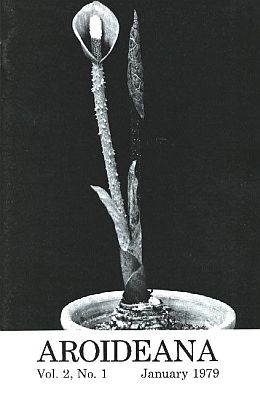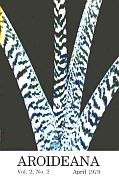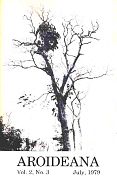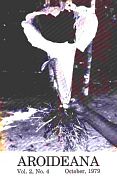|
|



Your search for articles published in volume 2 has found 18 articles.

|

| 
| 
| 
|
Articles of 3 pages or less are available for free to IAS members for download, and longer articles for $5. Articles from issues in 2016 and beyond are only available electronically, and are free to current members when they are logged in.
Please remember that all Aroideana articles are protected by copyright, and you may NOT distribute even electronic copies without permission from the authors or editor.
(Issue) |
||||
| S. J. Mayo | Aroids at Kew (Buy) | |||
| ABSTRACT: The Botanic Gardens at Kew first came into existence in the eighteenth century when Princess Augusta, mother of George III of Great Britain, had part of the Royal Estate at Kew converted for this purpose in 1759. We can gather some idea of the aroid collections at Kew in those early days from the famous "Hortus Kewensis", a threevolume work published in 1789, and written by William Aiton, Kew's first Head Gardener. From this source, in which all the species then in cultivation at Kew were described and classified, we know that the aroid collection amounted to 21 species, or more than half the total number known to the botanical world of the day. Since that time, of course, the number of described taxa of Araceae has mushroomed to the present approximately 2000 species and 110 genera, and though the aroid collection at Kew can fairly claim to be one of the most comprehensive to be found anywhere in the world today, its representation of some 70 genera and 450 species nevertheless leaves ample scope for expansion. | ||||
| Thomas B. Croat, George S. Bunting | Standardization of Anthurium descriptions (Buy) | |||
| ABSTRACT: A standardization of terminology for both new species descriptions and for floristic treatments would benefit other aroid workers as well as the general users of these works, since complete and uniform descriptions allow for more accurate comparisons. Furthermore, it is necessary to define the many special terms which are necessary to properly describe the species of An thurium. Some of these terms are used here for the first time, and while they are intended especially for use with Anthurium, many are equally appropriate for describing other genera of Araceae and plants of many other families. | ||||
| Josef Bogner | Professor Dr. Kurt Krause: 1883-1963
This article available FREE to IAS Members with a PERSONAL login. LOGIN, REGISTER or JOIN | |||
| ABSTRACT: The name K. Krause is well known to aroid lovers; it appears often as author, alone or together with A. Engler, in which case as Engl. et Krause. K. Krause was for a long time an expert on Araceae. | ||||
| Michael Madison | Aroid profile no. 3: Anthurium superbum
This article available FREE to IAS Members with a PERSONAL login. LOGIN, REGISTER or JOIN | |||
| ABSTRACT: Anthurium superbum Madison, Selbyana 5:94 (1978). Anthurium superbum is native to seasonally inundated forest along the Rio Napo in Ecuador, where it grows epiphytically above high water level. The dark purple-green bullate leaves held stiffly erect are very striking, and unlike any other anthurium. A large crop of seedlings is now being grown at Selby for distribution to botanical gardens and horticulturists. | ||||
| Thomas B. Croat | A new Anthurium from Panama
This article available FREE to IAS Members with a PERSONAL login. LOGIN, REGISTER or JOIN | |||
| ABSTRACT: Anthurium canasas Croat sp. nov. is described. | ||||
| Fred Dortort, Terry Thompson | Alocasias (Buy) | |||
| ABSTRACT: A locasia G. Don is a genus of east Asian aroids that contains a number of species of considerable horticultural interest. Members of the genus range from India to Taiwan and New Guinea, but the center of distribution is the Malay peninsula and the Indonesian and Philippine archipelagoes. Alocasia is closely related to the asian Xenophya and Colocasia and to the American genera Xanthosoma and Caladium. | ||||
| Michael Madison | Protection of developing seeds in neotropical Araceae (Buy) | |||
| ABSTRACT: In flowering plants with animal pollination and seed dispersal the reproductive cycle can be considered to consist of four stages, representing alternating phases of protection and display. In the protective phases immature flowers and fruits are safeguarded from predation and parasitism, while in the display phases pollinators and dispersal vectors are attracted. This alternation of protection and display is accomplished by a variety of mechanisms. | ||||
| Michael Madison | Aroid profile no. 4: Xenophya lauterbachiana
This article available FREE to IAS Members with a PERSONAL login. LOGIN, REGISTER or JOIN | |||
| ABSTRACT: Xenophya lauterbachiana (Engler)Nicolson, Blumea 16:117 (1968) Synonyms: Schizocasia lauterbachiana Engler Alocasia wavriniana Mast. Reference: Nicolson, D.H., 1968. The Genus Xenophya Schott (Araceae), Blumea 16:115-118. in primary lowland rainforest to elevations of 700m in northeastern New Guinea. The species was introduced into cultivation by Micholitz in the 1890's, and has been sparingly cultivated ever since, though it is a handsome plant that ought to be more widely grown. | ||||
| Michael Madison | Notes on some aroids along the Rio Negro (Buy) | |||
| ABSTRACT: In the fall of 1978 I spent several months collecting plants along the Rio Negro in the western Amazon in connection with the Projecto Flora Amazonas, an ambitious undertaking to prepare a new flora of the Amazon. Although my chief research interests on this expedition were not directed to aroids, I was able to make observations and collections of a number of species. | ||||
| Thomas B. Croat | Germination of seeds of Anthurium (Buy) | |||
| ABSTRACT: In my attempts to prepare a systematic revision of Anthurium, I have come to appreciate the value of living plants for study and I have consequently been attempting to assemble a more complete living collection of Anthurium. In addition to being used to prepare more complete and accurate descriptions, the plants are useful for associated studies with cytology, anatomy, floral fragrance chemistry and hybridization studies to determine relationships between species. | ||||
| S. J. Mayo, Graziela M. Barroso | A new predate-leaved species of Philodendron from Bahia (Buy) | |||
| ABSTRACT: Philodendron leal-costae Mayo et G. M. Barroso, sp. nov is described. | ||||
| Michael Madison | Aroid literature: Three new floras
This article available FREE to IAS Members with a PERSONAL login. LOGIN, REGISTER or JOIN | |||
| ABSTRACT: Croat, Thomas B. 1978. Flora of Barro Colorado Island, Stanford Univ. Press, 960pp., $55. Dodson, C. H. & A. H. Gentry, 1978. Flora of Rio Palenque, Selbyana Vol. 4, 628pp., $30. Steyermark, J. A. & O. Huber. 1978. Flora del Avila, Caracas, 971pp., $35. Are reviewed. | ||||
| Thomas B. Croat | The aroid collections at the Missouri Botanical Garden (Buy) | |||
| ABSTRACT: The Missouri Botanical Garden, which first opened its gates to the public in 1859, is the second oldest botanical garden in the United States, the oldest having been founded by John Bartram in Philadelphia early in the 18th century. Located on more than 70 acres in the heart of St. Louis, it features a large Japanese garden, a climatically controlled geodesic dome for tropical plants and numerous other indoor and outdoor displays. The Garden, long associated with Washington University, and more recently with St. Louis University, the University of Missouri and Southern Illinois University, has been involved in the training of many botanists. Its library with more than 65,000 volumes and its herbarium of about 3 million specimens play an important role in systematic botany and horticulture. | ||||
| Jim Watson | Growing climbing aroids
This article available FREE to IAS Members with a PERSONAL login. LOGIN, REGISTER or JOIN | |||
| ABSTRACT: Many of the best ornamental aroids, including Philodendrons and Monsteras, are vines which in the wild c1im b up the trunks of trees by means of adhesive roots formed along the stems. These present difficulties in cultivation because of their sprawling growth habits, and often they will revert to producing small juvenile leaves if they lack a support to grow on. Ordinarily they are provided by the grower with a tall stake of wood to climb up. However, in order to make a plant that is stable and not too top heavy the vine is usually severely overpotted, often in a three-gallon container when a one-quart size would be sufficient. | ||||
| Josef Bogner | Two new Aridarum species and one new variety from Sarawak (Buy) | |||
| ABSTRACT: Aridarum nicolsonii Bogner sp. nov., Aridarum burtii Bogner et Nicolson sp. nov. and Aridarum caulescens M. Hotta var. angustifolium Bogner et Nicolson var. nov. are described and a key presented. | ||||
| Mike Bush | Hybridizing anthuriums
This article available FREE to IAS Members with a PERSONAL login. LOGIN, REGISTER or JOIN | |||
| ABSTRACT: The genus Anthurium with over 600 species, contains many fine ornamental plants cultivated for their long-lasting and often striking foliage. One of the most rewarding aspects of growing anthuriums is the development of new forms by making hybrids between various species. The procedure for hybridizing anthuriums is relatively simple, and with a little patience and luck highly attractive new forms can be created. | ||||
| Anonymous | Heinrich Wilhelm Schott (1794-1865)
This article available FREE to IAS Members with a PERSONAL login. LOGIN, REGISTER or JOIN | |||
| ABSTRACT: Photo: H. W. Schott, the foremost authority on Araceae of his time, described about a third of the known genera and species of aroids. | ||||
| Michael Madison | Aroid profile no. 5: Anthurium punctatum
This article available FREE to IAS Members with a PERSONAL login. LOGIN, REGISTER or JOIN | |||
| ABSTRACT: Anthurium punctatum N. E. Brown, Gard. Chron. 26:809 (1886). Anthurium puncta tum is native to western Ecuador where it occurs as a pendent epiphyte in tropical wet forest. Like other pendent anthuriums with strap shaped leaves it makes a fine hanging basket plant in cultivation, especially if several shoots are established in a single basket. The plants should be planted in an open, well-drained soil and grown in moderate light. | ||||
All Images and Text © 1996 to 2024 by the International Aroid Society or by their respective owners as noted.
Please send your comments to
served by aws-web2
